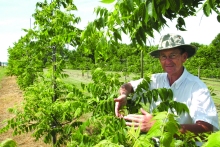Black Walnut
Development of Improved Black Walnut Selections for Use in Agroforestry Practices
Project Team: Mark V. Coggeshall, Michele R. Warmund, Ken Hunt, Aaron Brown
Black walnut is an admired Missouri tree species, known for high-value lumber and rich, distinct nut flavor. However, black walnuts are typically harvested in Missouri from the wild -- usually by hand by a landowner - often collected as they fall from trees in forested areas. This type of harvesting allows for significant inconsistencies in quality, size, flavor and level of ripeness, complicating production of this nut for consumer purchase. Due to these inconsistencies, wild-harvested nuts also command a lower market price than similar nuts produced with consistent qualities, such as the familiar size, color and flavor of the California walnut.

|
The Center for Agroforestry has been working since 1996 to develop black walnut into an orchard crop, striving for identification of the best-suited cultivars for Missouri climate and soils. Since the start of the applied breeding program, approximately 70 different black walnut nut cultivars have been acquired and placed in a series of grafted orchard collections at the University of Missouri Horticulture and Agroforestry Research Center (HARC) in New Franklin, Mo. Through orchard production, a consistent, top-quality nut can be harvested to meet consumer demand for a milder flavor and lighter color while retaining the black walnut's revered heart-healthy source of fat.
Black Walnut Genetic "Fingerprints"
In attempting to shift black walnut from a "backyard hobby nut tree" to a serious orchard
tree crop, it is essential that the exact genetic makeup of each cultivar is known. Dozens
of named cultivars exist, with many of these names created by tree hobbyists and shared
among one another. However, nut tree specialists must know how these cultivars differ
genetically to pursue hybridization techniques for producing improved black walnut cultivars
for an orchard setting. The genetic make-up, or "fingerprint," of each cultivar must be known
as the first step in an accurate breeding program.
To identify the genetic makeup of the Center's black walnut collection, nut tree researchers submitted leaf samples from all trees in the black walnut repositories at HARC in 2004 to the Hardwood Tree Improvement and Regeneration Center (HTIRC) at Purdue University. These samples provided DNA material for use in creating genetic fingerprints for each tree using a series of microsatellite markers.
Research Publications:
Reid, W., M.V. Coggeshall and K.L. Hunt. 2005. Black walnut cultivars for nut production. Walnut Council Bulletin 32(3):1,3,5,12,15.
Van Sambeek, J.W.; Garrett, H.E. 2005. Ground cover management in walnut and other hardwood plantings. In: Michler, C.H.; Pijut, P.M; Van Sambeek, J.W.; and four others. Black walnut in a new century (Proc., Sixth Walnut Council Symposium). Gen. Tech. Rep. NC-243. U.S. Department of Agriculture, Forest Service, North Central Research Station: 85-100.

